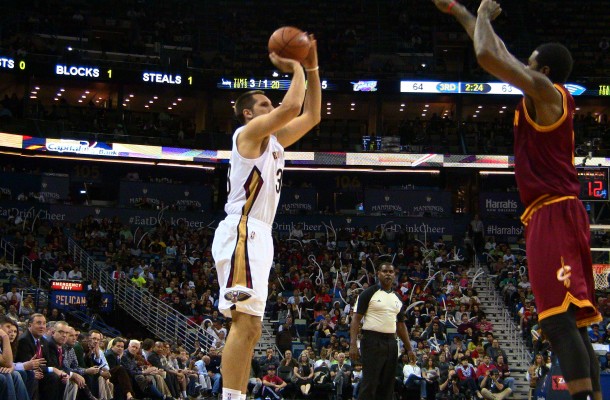« Tyreke Evans Hurt, Thunder Win
Offense isn’t the Problem and Opponent BS Rate »
Life After Davis: The Rise of Ryno

Ryan Anderson spun, stuck his right shoulder into Joakim Noah, rose up for the shot.. and buried it. Noah’s shoulders slumped: all night, he had been put in the impossible position of choosing to help and leave Anderson open or to stay and allow an easy shot at the rim. This time, he was right in Anderson’s face, but he was powerless to stop him.
You know you’re doing something right when you’re upsetting Noah, one of the league’s best defenders. And right now, just about everything on the court is going right for Ryan Anderson, who is shooting a scorching 50% from 3 point land.
2 summers ago, the Pelicans acquired Anderson in a sign-and-trade with the Orlando Magic, who were preparing to trade Dwight Howard and overhaul their roster. His deal of roughly 34 million over 4 years was questioned by some who believed Anderson’s production was a product of Dwight Howard’s dominance, even though statistics didn’t tell the same story.
Fast forward to today, and there is no doubt that Anderson is worth every penny, as he is averaging almost 22 points per game on efficient shooting. The season’s initial goal of playoffs looks almost certain to be lost, as the Pelicans are having trouble stopping just about anyone without Davis roaming the paint. But the Finishing Five’s stint, though brief in length, proved to be everything Pelicans fans hoped it would be- and undoubtedly, Anderson’s shooting was a large part of that.
Anderson is an unusual offensive weapon. He sports one of the fastest pick and pop releases in the game (at 6’9, no less), always maintains his balance on shots, and is damn near impossible to block when shooting from distance. He knows where to be, and despite being (by far) the Pelicans’ most consistent perimeter threat, he always manages to be find ways to get open. He carves out space on the offensive boards against players bigger and more athletic than he is.
It is ironic that Anderson’s rise comes with such poor timing: Davis is the future of this franchise, and after an offseason spent wondering whether a frontcourt tandem of Davis and Anderson could get it done, the Pelicans were outscoring their opponents by an average of 12 points per 100 possessions with the pair on the court.. and then, in typical New Orleans basketball fashion, the glimmer of hope that fans enjoyed faded with another terribly-timed injury (to Davis). The sample size was small, but the production was real, and it’s hard to think of a finishing frontcourt that sports two offensive options with such perfectly complementary offensive skills. The defense will need work and much of it rests upon Davis’s ability to fill into his frame.
But reality can be harsh and the Pelicans will be without Davis for an indefinite time period and Evans for a while as well. Until they return, the Pelicans’ unfavorable chances of winning games short-handed largely rest on Ryan Anderson’s shoulders: the offense goes as his shooting goes, and the team’s defense just doesn’t go. The Pelicans will have to make their difference on the offensive end, and his production is key.
Anderson’s rates will come down. High volume 3 point shooters rarely can sustain 50 percent rates from deep, no matter how good they are. His production will dip to a more reasonable level, presumably in the high 30 to low 40 percent range.. and that’s okay, because in a league full of overpaid big men, Ryan Anderson is scoring over 20 points per game on a contract worth between 8 and 9 million. Expectations for our season must be adjusted, and if you are looking for a reason to hope, Anderson’s growth as a player is a good place to look.




